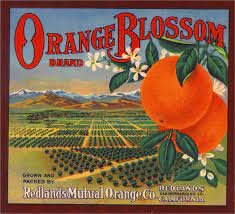My love of fruit crate labels
I have always loved fruit crate labels. Occasionally I’d see them in antique shops or decorating stores. With vivid colors and beautiful scenes of rural California, some of them are absolutely gorgeous. Whenever I’d come across them, I couldn’t help but think what it must have been like during the early days of California agriculture.
But I didn’t know much about them or their history. So I started researching.
Fruit crate labels were created in the 1880s and used for about 70 years by California citrus growers to identify and advertise the wooden boxes of oranges they shipped throughout the United States. Since the late 1700s when they were first grown in California, brought from Mexico by the Spanish colonists, oranges were grown mainly for local consumption. The construction of the Southern Pacific and Santa Fe railroads in the late 1870s finally linked Southern California with the rest of the continent. This provided an eastern market for the fruit and led to the rapid influx of new settlers who recognized the agricultural promise of the state. I can only imagine how they must have inspired not only fruit buyers to buy the fruit, but also individuals looking to move out west, to this “promised land” of wide open spaces and golden opportunities, and indeed, many settled in rural areas and planted orange groves.
These early growers had a new kind of problem that had never been faced on this scale before - how to pack, ship, identify and advertise a perishable product for customers who lived thousands of miles away. The brightly colored and attractively designed paper label proved to be a key ingredient in the solution to this problem.
The earliest surviving labels are small circular paper images about 6” in diameter, which were pasted in the center of a rectangular stencilled pattern. They were quickly superseded by larger labels, about 11”x10” and the dimensions of these orange box labels didn’t change for the next 70 years. Their purpose was to catch the attention and interest of prospective purchasers. In the hands of a good artist and graphic designer, the orange box label became an elegant small poster, containing an easily understood and remembered message.
The first labels were produced by stone lithography, sequentially printing up to 6 colors to form the final image. The California printing industry, which produced nearly all the labels, was located in San Francisco and Los Angeles. While the dimensions and product identification requirements for labels remained unchanged for the seven decades of label use, the specific art treatment used gradually evolved, reflecting new advertising concepts, design themes, and production techniques. A chronological survey of orange box labels provides an encapsulated history of American commercial art during this period.
The first 35 years of label production, from the mid-1880s until the end of World War I, was one in which label themes and designs revolved around a naturalistic point of view, which was in line with American popular art of the period. Flowers, birds, animals, historical themes and scenic views were “in”.
A change took place in the 1920s, along with the transition in America from a predominantly rural to an urban society and an emphasis on product advertising. The labels began to stress the health benefits to eating oranges and consuming orange juice. New designs, themes, and innovative use of color were employed.
The final period, from the mid-1930s to to the mid-1950s, featured designs based on commercial art school concepts.
The labels came to an end in the 1950s when cardboard cartons replaced wood boxes. Wood had become more expensive, the cost of labor to assemble them rose, and cardboard containers were developed that were strong enough to survive rough shipping conditions.
During the period of label use, over 8000 distinct designs were developed, and used on over 2 billion boxes of oranges. Label artists often considered their work to be less prestigious than the magazine covers or national product advertisements. Many lithographic companies had restrictions against signed work so practically no label design bears the artist’s signature. In spite of their anonymity over 50 labels artists have been identified.
There are many people that are interested in collecting labels. Most early ones are rare. Later labels exist in larger quantities and form a large body of material available to people interested in collecting and studying this graphic form of American commercial art.
I often thought of ways that they could be incorporated in my decor, or displayed in some fashion. And then I went through a divorce and decorating was the last thing on my mind. When I finally settled in my new place, I had the chance to resurrect this interest.
I discovered a vast array of reproduction as well as original labels on eBay. I started buying a few here and there not entirely sure of how I would display them. Eventually I thought it would be cool to affix 1 or 2 of them on an actual fruit crate. I found a store in Anaheim, California that sells used and vintage fruit crates. I realized that there wasn’t enough space to display that many crates in the kitchen, so I decided to dismantle all but 1 of the boxes and use the wood as planks to affix the labels to. The wooden planks were then displayed around the top perimeter of the kitchen.
My only requirement for the label was that it depicted a grower in the Southern California area. So now I finally get to display some of my favorite vintage fruit crate labels representing the region from which I came, rich in agricultural history.









